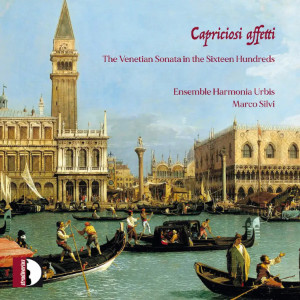
Capriciosi affetti – The Venetian Sonata in the Sixteen Hundreds
Ensemble Harmonia Urbis
rec. 2023, Sant’Eligio dei Ferrari, Rome, Italy
Reviewed as a stereo 16/44 download from Naxos
Stradivarius STR37295 [62]
The title of the disc under review is well-chosen, as its two words refer to some of the main features of the music’s style. Capricioso is derived from capriccio, which, according to New Grove, “does not signify a specific musical technique or structure, but rather a general disposition towards the exceptional, the whimsical, the fantastic and the apparently arbitrary.” That is a good description of the style which was born in Italy around 1600 and was called by Athanasius Kircher the stylus phantasticus.
With the word affetti we are in the sphere of human emotions: after 1600, the ideal of composers was to arouse the listener’s emotions, not only in vocal music, but in instrumental music as well. And as man is often the victim of contrasting emotions, and one feeling can easily turn into its opposite, the stylus phantasticus is the perfect way to express such emotions.
The programme consists of music by the main – or, rather, the best-known – representatives of that style. I would have liked a more adventurous programme; all the pieces included here are available in a number of recordings, so the lover of such music is unlikely to hear anything not heard before. That said, there is some variety in the programme in that the contrasts are of various kinds.
The disc opens with the Sonata XVIII by Marco Uccellini, in which the various sections are written in opposing rhythms. In the next item, the Sonata VII by Giovanni Battista Fontana, the contrasts also come from the juxtaposition in scoring: episodes for the two violins alternate with solo passages of the first and the second violin respectively.
The sonata was a relatively new genre, which gradually overshadowed the canzona, the main form of instrumental music of the late Renaissance. However, there is no watershed between the two genres; canzonas were still written, and often they are not fundamentally different from the sonata. Giovanni Picchi’s Canzona IV is dominated by counterpoint, but includes solo passages. He is at his most experimental in his keyboard works, although the two pieces here are dances rooted in the Renaissance.
Two pieces are different from the others in that they are based on traditional songs. Both are by Biagio Marini, one of the most brilliant violinists of his time. La Monica was a popular song used for variations by several composers, such as Girolamo Frescobaldi, and was known under different names in England, France and Germany. The other is called Fuggi, and is also known as La Mantovana or Il Ballo di Mantova. In later times, it became known from Bedřich Smetana’s Vltava and the Israeli national anthem Hatikvah. Marini is also the composer of the Capriccio che due violini sonano quattro parti. The two violin parts include double stopping which results in four parts – one of the innovations in violin playing in the early 17th century.
The sonatas and canzonas from the early 17th century consist of a sequence of short, contrasting sections, which follow each other attacca. In comparison, the sonatas from the late 17th century are usually divided into clearly separated movements. The sonatas by Arcangelo Corelli are the ultimate proof of this development, but before him other composers already moved in this direction. Giovanni Legrenzi is generally considered an important link between the early and the late 17th century. His Op. 2. includes eighteen sonatas; one of them is by his father Giovanni Maria. The remaining seventeen sonatas are of a different scoring: six are for two violins (La Cornara), three for violin and violone or bassoon (La Foscari and La Donata) and nine for two violins and violone or bassoon (La Zabarella), all with basso continuo. These sonatas are divided into different sections with contrasting tempo indications. They include solo episodes.
As far as the performances are concerned, the last four items shed light on a less convincing aspect: the use of a cello as bass instrument. Legrenzi’s Op. 2 was published in 1655, and at that time the instrument we now know as (baroque) cello did not exist. It is no coincidence that the score uses the word violone, which in Italy at the time refers to a large bass violin. I would have liked such an instrument to be used here. It is anachronistic in the earlier sonatas as well, but in them the string bass does not play a prominent role.
Otherwise, I enjoy this disc by an ensemble that I had not heard before; the booklet does not include any information about it. There is no reason to hide its identity. The programme may be a little predictable, the performances are well worth listening to and can compete with what is already on the market. For those who are not familiar with this repertoire, this disc offers a good opportunity to get to know it. The liner-notes deliver the information one needs to put these pieces into their historical context.
Johan van Veen
www.musica-dei-donum.org
twitter.com/johanvanveen
If you purchase this recording using a link below, it generates revenue for MWI and helps us maintain free access to the site



Contents
Marco Uccellini (1603-1680)
Sonata XVIII a doi violini [op. 4]
Giovanni Battista Fontana (c1589-c1630)
Sonata VII a due violini
Biagio Marini (1594-1663)
Sonata sopra La Monica a 3, op. 8,45
Dario Castello (fl 1620-1630)
Sonata X a 3 [1629]
Biagio Marini
Sonata sopra Fuggi, op. 22,21
Giovanni Picchi (fl c1600-1625)
Canzona IV a doi violini
Todescha
Ballo ditto il Pichi
Biagio Marini
Sonata III variata, op. 8,58
Capriccio che due violini sonano quattro parti, op. 8,14
Giovanni Legrenzi (1626-1690)
Sonata La Foscari, op. 2,8
Sonata La Zabarella, op. 2,10
Sonata La Donata, op. 2,7
Sonata La Cornara, op. 2,1

















